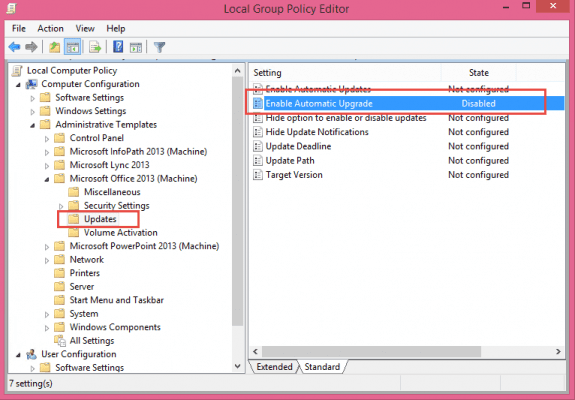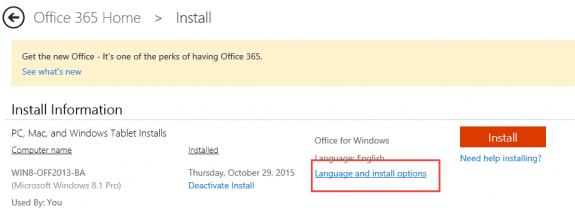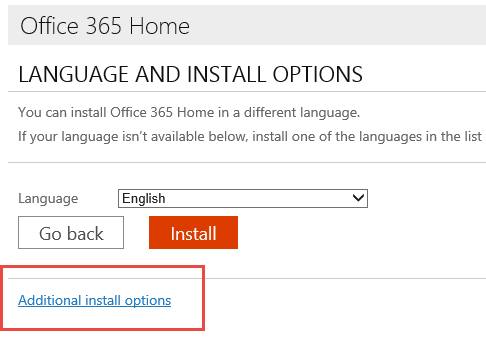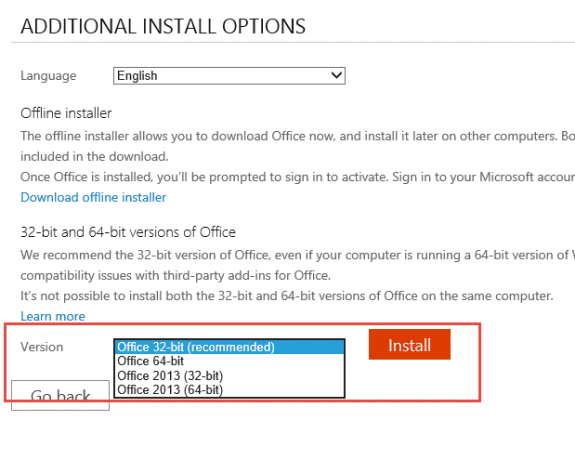This content has been archived. It may no longer be relevant.
August 18 2017: See this Microsoft article for the current status of Office 2013: Office 2013 and Office for Mac 2011 are no longer available for installation with an Office 365 subscription. Currently, you can download Office 2013 using "direct download links".
Office 365 Home, Personal, and University subscribers who upgraded to Office 2016 and want to revert to Office 2013 are now able to install Office 2013 from their account portal.
Business subscribers can also download Office 2013 if they need to downgrade to the older version.
Reminder: If you are connecting to Exchange 2007 or BCM, you don’t want to upgrade.
Consumer & University Subscribers
Consumer subscribers will find the link to Office 2013 in their account, hidden under the Install section.
- Click Language and Install Options

- Then click Additional install options.

- Office 2013 is on the Version menu.

Did you know consumers can download a copy of Office 2016 to install offline from this page?
Business Subscribers
If you choose to reinstall Office 2013, make sure you uninstall Office 2016 (or use
the Fix It tool to remove it) and reboot. Before installing 2013, you should set the enableautomaticupgrade registry key to block upgrades.
Office 365 subscribers will be able to install either Office 2013 or Office 2016 from their software portal if First Release is enabled. The steps are similar to the consumer version: Go to the page to download a different language to find it.
The big orange “Install Now” button on the main page will install Office 2013. If you want Office 2016, click Change (to the right of Language) to find the Office 2016 install files. That will take you to the page with additional language options, where you’ll have the choice of 32 or 64 bit installs of either Office 2013 or Office 2016, as well as choose different languages. Mac Office (2011 or 2016) is available when you log in from a Mac.
Block Upgrades using GPO
Businesses using Group Policy can block the automatic updates using the updated Office 2013 group policy template. Look for the option to block updates under Computer Configuration\Administrative Templates\Microsoft Office 2013 (Machine)\Updates.
Double click on Enable Automatic Upgrade and choose Disabled, then click Apply and close the dialog. If Outlook is open, close and restart it.

Block Upgrade using Registry
Anyone can block the updates by setting the following registry key (create the keys if they are missing):
HKEY_LOCAL_MACHINE\SOFTWARE\Policies\Microsoft\office\15.0\common\officeupdate
DWORD: enableautomaticupgrade
Value: 0
You'll need to close and restart Outlook for values under the policy key to apply.
If you don't want to edit the registry yourself, download then run this reg file to set the key.
enableautomaticupgrade
More Information
If you aren't sure what your language code is, see Language Codes for a list of valid language codes. Note that Office 2013 is not available in all languages listed in that document.
Obtaining older versions of Office
Special offer for customers with Office 2016 and Office 2013 standalone applications



Diane,
-Thanks for having such a useful site!
GOAL:
-I need your help downgrading to Office 2013.
-My 4-yr old Dell Inspiron 660 (i5-2320 3.0 Ghz, 8GB RAM, 2TB HD, Win 7 Home Premium 64-bit) cannot sustain Office 2016. Blue screens...
BACKGROUND:
-I subscribed to Office 365.
-I rely heavily on Outlook, with 1,500+ contacts (including lots of data in 'notes' sections of contacts), 3 email addresses with 15 years of history and many folders, and 10+ calendars (developed when I used Google Calendars). PROGRESS:
-I downloaded and used the suggested Fix it Tool to remove Office 2016.
-I rebooted.
-I need to block auto upgrade.
-I looked for the suggested: HKEY_LOCAL_MACHINE\SOFTWARE\Policies\Microsoft\office\15.0\common\officeupdate.
-However, my registry reads: HKEY_LOCAL_MACHINE\SOFTWARE\Policies\Microsoft\office\15.0\Outlook\Security.
I would greatly appreciate your advice and insight!
Scott
Sorry I missed this earlier. if a key does not exist, you need to add it.
Hi! Can you tell me why I might want to downgrade from 2016 to 2013? Are there major issues that are motivating users to downgrade? I didn't see this covered in the post. If is covered somewhere else on the website, please direct me to that article. Thanks!!
Brett
Houston, TX
Generally speaking, no, you wouldn't want to downgrade... but if you use software that was not yet updated to work with 2016, then you would need to downgrade.
When I try to go back to Office 2013, this is what I get.
An error has occurred. We can’t move on to the next step. Please try again later.
01bf2b47-c6dc-4178-a07f-709fae8f08e4
your txt says HKLM and your registry file says HKCU - which is it?
Use local machine. I'll fix the reg file. Thanks.
Glad that the website name aint lipstick lol
Please review this post about down grading to Office 2013. It looks like microsoft pulled the down grade. https://support.office.com/en-us/article/Office-2013-and-Office-for-Mac-2011-are-no-longer-available-for-installation-with-an-Office-365-subscription-de68fd95-553a-4c38-b1b5-e4205b96fc75?wt.mc_id=O365_Comm_MySft_Office_Install_GetO13&ui=en-US&rs=en-US&ad=US
Office 2013 and Office for Mac 2011 are no longer available for installation with an Office 365 subscription
I don't have any links for Outlook 2011 for mac (and I'm not sure there are any), but do have direct download links for office 2013 for windows at https://www.slipstick.com/outlook/2013/office-2013-removed-office-portal/ (I haven't had a chance to test any since the latest announcement - will try that next).
As an FYI, the direct link for Home Premium still works. (Home & Business link installs 2013 - I mistakenly clicked that link and could not activate it.)